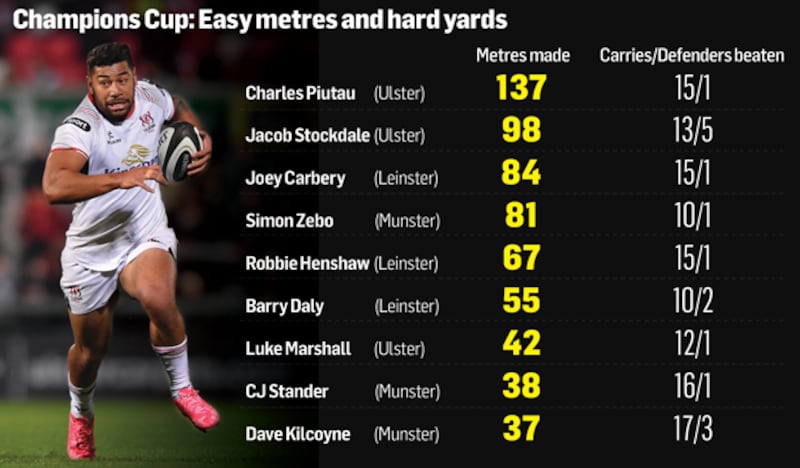Privately players may derive satisfaction and partially measure their effectiveness in a match based on positive statistical data, although publicly less inclined to do so in the belief that those numbers may offer a rod for the next outing.
Leading the categories like tackle count, ball carrying, offloads, clean breaks and defenders beaten are positive indicators, providing a skeleton upon which the flesh of the performance is added. Technology allows for an individual’s performance to be isolated as if playing the match on his own for the 80-minutes.
There is no escape as many a player has discovered during a Monday review. However one statistical category is heavily skewed in favour of a select group of players – leaving aside niche markers like lineouts won – and it falls under the heading, ‘metres made’.
Reflecting on last weekend's opening round of Champions Cup fixtures there is a commonality to the positions of the players that top the standings. Take for example the three Irish provinces, Ulster, Leinster and Munster and seven of the nine players illustrated in the graphic below are fullbacks, wings or centres; as an aside five of the group scored tries.

The two exceptions are Munster players, number eight CJ Stander and prop Dave Kilcoyne, an excellent feat on their part given the physical challenges forwards face to rack up positive figures.
Where fullbacks are occasionally recipients of loose kicking that allows them to field possession and run 20 metres before being accosted by a member of the opposition, there is less wriggle room in the more cluttered corridors around ruck, maul and scrum.
For the purposes of the column I looked at Munster’s 17-17 draw against Castres Olympique at the Stade Pierre Antoine last weekend.
Munster’s team total of ‘metres made’ was a relatively low 298 with fullback Zebo, Stander and Kilcoyne contributing 52 per cent of the overall figure and the two forwards, 25 per cent.
In delving beneath the figures, it should be acknowledged that the Scannell brothers, hooker Niall and centre Rory, both enjoyed superb games in terms of getting Munster over the gain-line, often finding a passage through heavy defensive traffic.
Zebo's first invention came inside three minutes. Castres outhalf Benjamin Urdapilleta cleared the ball down the pitch. The Munster fullback fielded possession one metre outside his 22 and the first point of contact with the chasing line of Castres tacklers was about nine metres short of the halfway line.
His most substantial accumulation of metres came in the 26th minute when he collected another poorly directed Urdapilleta kick, again in the shadow of the Munster 22.
On this occasion, he raced to the 10-metre line, used his footwork to ghost between two tacklers before being eventually hauled down after several strides inside the Castres half. In two carries he made about 60 metres of which about 45 would have been unencumbered by tacklers.
It’s not a criticism because the same latitude is afforded to fullbacks in most matches, amateur and professional and in specifically addressing Zebo’s performance against Castres, his try was sharply taken – matched by Conor Murray’s vision and pass – and he invariably chose the right option.
Zebo's average of eight metres per carry was only just behind that of Ulster fullback Charles Piutau (9) and while those of Stander (2.3 metres) and Kilcoyne (2.1 metres) pale when judged against the marketing leading numbers it's not a fair comparison when weighted against the physical environment in which the two Munster forwards carried for the most part.
The sole occasion that Kilcoyne carried outside the 10 channel, he made about 12 metres, breaking two tackles in the process. He scored one try, might have had another and gave his team multiple positive gain-lines in an outstanding performance.
Stander’s power was also in evidence and while he made less eye-catching sallies, he took responsibility to turn static ball into something more useful.
As Munster face into Saturday’s Champions Cup game against Racing 92 at Thomond Park, the figure that may preoccupy them most is the team’s total metres made of 298. That’s well below their average per game – Castres had almost 100 more in a 17-17 draw – and it’s not fully explained by the fact that they kicked (29) more often than their opponents (20).
They’ll need to increase that figure irrespective of whether it’s ‘easier’ metres or hard yards.















